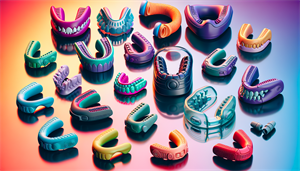Wondering whether snoring mouthpieces vs nasal strips are better for you? This article breaks down their differences, benefits, and limitations to help you decide.
Key Takeaways
-
Understanding the causes of snoring is crucial for selecting the right remedy, as various conditions like nasal congestion or structural abnormalities can affect airflow.
-
Nasal strips provide immediate relief for nasal congestion-related snoring, while snoring mouthpieces are generally more effective for throat-related issues and obstructive sleep apnea.
-
Consulting a sleep specialist and making lifestyle changes can enhance the effectiveness of anti-snoring devices and help address underlying sleep disorders.
Understanding Snoring and Its Causes

Snoring occurs when airflow through the upper airway vibrates tissues, causing sound. This seemingly simple act can be a symptom of underlying issues. From nasal congestion to structural abnormalities, various factors can narrow the nostrils and restrict airflow. Keeping nasal passages clear through hydration and rinses can help mitigate snoring.
Several conditions contribute to nasal obstruction, such as congestion, deviated septum, narrow nostrils, and weak supportive tissues. These obstructions can lead to the infamous snoring sound that disrupts sleep. Identifying these causes is key to finding the right solution to stop snoring and improve sleep quality.
Moreover, conditions like sleep apnea and obstructive sleep apnea can exacerbate snoring. It’s essential to identify whether your snoring is a benign annoyance or a symptom of a more severe sleep disorder. Identifying the root causes allows for more effective efforts in reducing snoring.
What Are Nasal Strips?

Nasal strips are adhesive strips applied to the nose to open the nostrils and facilitate better airflow. These strips work by mechanically widening the nasal passages, which reduces nasal airway resistance and allows for easier breathing. Improved airflow from a nasal strip can mitigate snoring due to nasal obstruction.
However, nasal strips are not a one-size-fits-all solution. While they can be beneficial for some, they have their limitations. Knowing the benefits and limitations of nasal strips helps determine if they are the right anti-snoring device for you.
Benefits of Nasal Strips
Nasal strips can provide immediate relief for individuals experiencing nasal congestion. Holding the nostrils open enhances airflow through the nasal passages and may reduce snoring for some users. Many users report a decrease in the frequency and intensity of their snoring, leading to a more restful sleep experience.
Despite mixed scientific evidence, many users find nasal strips helpful in reducing snoring. While objective sleep studies often do not show a significant change in snoring levels, the subjective experiences of users highlight the potential benefits of nasal strips in improving sleep quality.
Limitations of Nasal Strips
While nasal strips can assist with nasal-related snoring, they do not address snoring due to issues with the soft palate or uvula. This means that if your snoring is caused by throat-related obstructions, nasal strips may not be effective. Additionally, nasal strips can sometimes cause skin irritation, especially with prolonged use or on sensitive skin.
It’s important to recognize these limitations when considering nasal strips as your anti-snoring device. They are best suited for individuals whose snoring is primarily caused by nasal congestion or obstruction, rather than those with more complex airway issues.
What Are Snoring Mouthpieces?

Snoring mouthpieces, also known as mouthguards, aim to reduce snoring by expanding the airway, stabilizing the tongue, or employing both methods. These devices are designed to keep the airway open during sleep, thereby reducing the likelihood of snoring. There are primarily two types of snoring mouthpieces: mandibular advancement devices (MADs) and tongue-retaining devices (TRDs).
Knowing the types of snoring mouthpieces, their benefits, and limitations aids in deciding if they suit your snoring issues. Let’s explore these aspects in detail.
Types of Snoring Mouthpieces
Mandibular advancement devices work by pulling the jaw forward, which helps to keep the airway clear. These devices are dental apparatuses designed to keep the airway open by repositioning the lower jaw. On the other hand, tongue stabilizing devices use suction to hold the tongue in place, preventing it from blocking the airway.
Both types of mouthpieces serve the primary function of maintaining an open airway during sleep, which can significantly reduce snoring and in some cases, treat obstructive sleep apnea. Choosing the right type depends on the specific cause of your snoring and your comfort with the device.
Benefits of Snoring Mouthpieces
Snoring mouthpieces can enhance airflow, thereby helping to alleviate snoring, including among those who suffer from obstructive sleep apnea and mouth breathing. These devices maintain an open airway, significantly improving sleep quality and reducing loud snoring frequency. This can lead to a more restful sleep for both the snorer and their bed partner.
While nasal strips may be less effective for severe snoring cases, mouthpieces offer a more robust solution for individuals with throat-related snoring issues. Their ability to improve airflow and provide relief for obstructive sleep apnea patients makes snoring mouthpieces a valuable option in the fight against snoring.
Limitations of Snoring Mouthpieces
Despite their effectiveness, snoring mouthpieces have several limitations. Some users may encounter jaw pain or discomfort due to the use of mandibular advancement devices. Additionally, improper use of these devices may potentially lead to misalignment of teeth over time.
It’s crucial to use snoring mouthpieces correctly and under the guidance of a healthcare professional to avoid these potential issues. Knowing these limitations helps in making an informed decision about using a snoring mouthpiece.
Comparing Effectiveness

When comparing the effectiveness of nasal strips and snoring mouthpieces, it’s clear that both devices have their strengths and weaknesses. Nasal strips provide immediate relief from nasal congestion by opening the nasal passages, making breathing easier during sleep. However, they may be ineffective for snoring caused by issues related to the soft palate or uvula.
Snoring mouthpieces, such as mandibular advancement devices, are designed to reposition the jaw or tongue to keep the airway open. These devices are generally more effective for individuals with throat-related snoring issues and can also help those with obstructive sleep apnea. However, they can cause initial discomfort, jaw pain, and issues with teeth alignment.
Clinical studies indicate that both nasal strips and snoring mouthpieces can reduce snoring, but their effectiveness often varies based on the underlying cause of snoring. User experiences suggest that snoring mouthpieces may be more effective for those whose snoring is related to airway obstruction, while nasal strips are often better for individuals with nasal congestion.
Clinical Studies and User Experiences
Conflicting study results regarding the effectiveness of nasal strips show that while users report reduced snoring, sleep studies suggest there may be no significant difference. However, users typically report less frequent and intense snoring when using nasal strips, leading to a more restful sleep experience.
On the other hand, snoring mouthpieces have been shown to significantly reduce snoring intensity, as reported by bed partners. Users often experience improved sleep quality and reduced sleepiness, making these devices a popular choice for those with severe snoring issues.
Suitability for Different Conditions
Nasal strips are generally more suitable for individuals with nasal congestion rather than those suffering from obstructive sleep apnea. These strips are not effective for obstructive sleep apnea, making them less suitable for individuals with this condition. Instead, those experiencing severe snoring due to throat issues may find mouthpieces to be a more suitable option.
Identifying the cause of your snoring aids in choosing the right device. Whether it’s nasal congestion, sinus infections, or nasal polyps, the choice of device is critical for effective relief.
Choosing the Right Solution

Selecting the right anti-snoring device necessitates considering individual needs, the severity of snoring, and any existing health issues. Consulting with a sleep specialist can provide personalized recommendations tailored to specific snoring causes and conditions. Additionally, lifestyle modifications can complement the use of anti-snoring devices and enhance their effectiveness.
It’s crucial to consider effectiveness, usability, and individual health conditions when choosing an anti-snoring device. Let’s explore the importance of consulting a sleep specialist and making lifestyle changes to improve snoring and overall health.
Consulting a Sleep Specialist
Individuals should screen for obstructive sleep apnea before trying anti-snoring solutions. If experiencing jaw or tooth pain from a mouthpiece, it’s important to talk to a doctor for alternative device suggestions. Consulting a sleep doctor or specialist is essential for personalized recommendations.
Sleep specialists can conduct a sleep study to diagnose any underlying sleep disorders and provide tailored advice on the most suitable anti-snoring device. This professional guidance can significantly improve sleep quality and reduce snoring, as well as inform patients about sleep medicine options.
Lifestyle Modifications
Implementing lifestyle changes, such as weight reduction and altering sleep positions, can significantly improve snoring and enhance the effectiveness of other treatments. Weight loss can assist in alleviating snoring for some individuals, particularly if weight gain has occurred. Adopting a healthier lifestyle can enhance the effectiveness of nasal strips and other anti-snoring devices.
Changing sleep positions, such as sleeping on your side, may help reduce snoring. Additionally, avoiding alcohol before sleep can decrease the likelihood of snoring due to relaxed throat muscles.
These lifestyle changes can complement the use of anti-snoring devices and improve overall sleep quality.
Alternative Remedies
Besides nasal strips and snoring mouthpieces, there are other remedies to consider. Internal nasal dilators, such as the Mute nasal dilator, can reduce snoring. The Mute nasal dilator is eligible under HSA/FSA, suggesting financial options for users. Additionally, the eXciteOSA device has been FDA authorized for snoring and mild sleep apnea.
Surgical options are generally considered when structural issues in the airway are present. These alternative remedies offer additional ways to address snoring and improve sleep quality.
Summary
Nasal strips and snoring mouthpieces both offer potential solutions for reducing snoring. Nasal strips are effective for those with nasal congestion, while mouthpieces are better suited for individuals with throat-related snoring issues. Consulting a sleep specialist and making lifestyle changes can enhance the effectiveness of these devices.
Ultimately, the right solution depends on the specific cause of your snoring and your individual needs. By understanding the benefits and limitations of each device, you can make an informed decision and take steps towards quieter nights and better sleep.
Frequently Asked Questions
Can nasal strips help with sleep apnea?
Nasal strips are not effective for treating obstructive sleep apnea and are best suited for those experiencing nasal congestion. It's important to explore more appropriate treatments for sleep apnea.
Do snoring mouthpieces cause jaw pain?
Yes, snoring mouthpieces can cause jaw pain, particularly with mandibular advancement devices. It's advisable to consult a doctor if you experience discomfort.
How do nasal strips work?
Nasal strips increase airflow by physically widening the nostrils, which effectively reduces nasal airway resistance for easier breathing. This simple solution can significantly improve comfort, especially during sleep or exercise.
Are there any side effects of using nasal strips?
Yes, nasal strips can cause skin irritation, especially with prolonged use or on sensitive skin. It's important to monitor your skin's reaction if you use them frequently.
What lifestyle changes can help reduce snoring?
To effectively reduce snoring, consider losing weight, changing your sleep position, and avoiding alcohol before bedtime. These lifestyle adjustments can lead to significant improvements.

